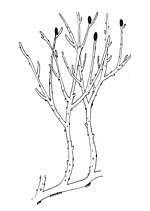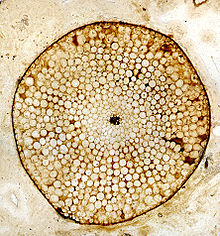Rhynia
| Rhynia Temporal range:
| |
|---|---|

| |
| Reconstruction of Rhynia gwynne-vaughanii, redrawn after Kenrick & Crane (1997:101)[1] | |
| Scientific classification | |
| Kingdom: | Plantae |
| Clade: | Tracheophytes |
| Subdivision: | † Rhyniophytina
|
| Class: | † Rhyniopsida
|
| Order: | † Rhyniales
|
| Family: | † Rhyniaceae
|
| Genus: | †Rhynia Kidst. & W.H.Lang (1917) |
| Type species | |
| R. gwynne-vaughanii Kidst. & W.H.Lang (1917)
| |
| Species | |
| |
Rhynia is a single-species genus of
Description
Rhynia gwynne-vaughanii was first described as a new species by

Rhynia is thought to have had deciduous lateral branches, which it used to disperse laterally over the substrate[5][6] and stands of the plant may therefore have been clonal populations.
Evidence of the
Taxonomy
Two species of Rhynia were initially described by R. Kidston and W. H. Lang from the Rhynie chert bed: R. gwynne-vaughnii in 1917,[3] and R. major in 1920.[13] R. gwynne-vaughanii was named by Kidston and Lang in honour of their late friend and colleague, the botanist David Thomas Gwynne-Vaughan.[3]
A study of the vascular tissue of the two by David S. Edwards in 1986 lead to the conclusion that the cell walls of the water-conducting cells of R. major lacked the secondary thickening bars seen in the xylem of R. gwynne-vaughanii, and were more like the water-conducting hydroids of moss sporophytes. His conclusion was that R. gwynne-vaughanii belongs in the vascular plants, while R. major belongs among the bryophytes. Accordingly, he transferred it to a new genus Aglaophyton, leaving R. gwynne-vaughnii as the only known species of Rhynia.[14] Rhynia is the type genus for the rhyniophytes, established as the subdivision Rhyniophytina by Banks,[15] but since treated at various ranks.
Phylogeny
In 2004, Crane et al. published a
| polysporangiophytes |
| ||||||||||||||||||||||||||||||||||||
References
- ISBN 978-1-56098-729-1. Fig. 4.8, p. 101.
- .
- ^ .
- .
- .
- .
- ^ H. Kerp, N.H. Trewin and H. Hass (2004) New gametophytes from the Early Devonian Rhynie chert. Transactions of the Royal Society of Edinburgh, Earth Sciences, 94, 411–428
- .
- ^ Remy, W.; Remy, R (1980). "Lyonophyton rhyniensis n. gen. et nov. spec., ein Gametophyt aus dem Chert von Rhynie (Unterdevon,Schottland)". Argumenta Palaeobotanica. 6: 37–72.
- ^ Remy, W.; Hass, H. (1991a). "Langiophyton mackiei nov. gen., nov. spec., ein Gametophyt mit Archegoniophoren aus dem Chert von Rhynie (Unterdevon Schottland)". Argumenta Palaeobotanica. 8: 69–117.
- ^ Remy, W.; Hass, H. (1991b). "Kidstonophyton discoides nov. gen. nov. spec., ein Gametophyt aus dem Chert von Rhynie (Unterdevon, Schottland". Argumenta Palaeobotanica. 8: 29–45.
- .
- .
- .
- .
- PMID 21652317.
